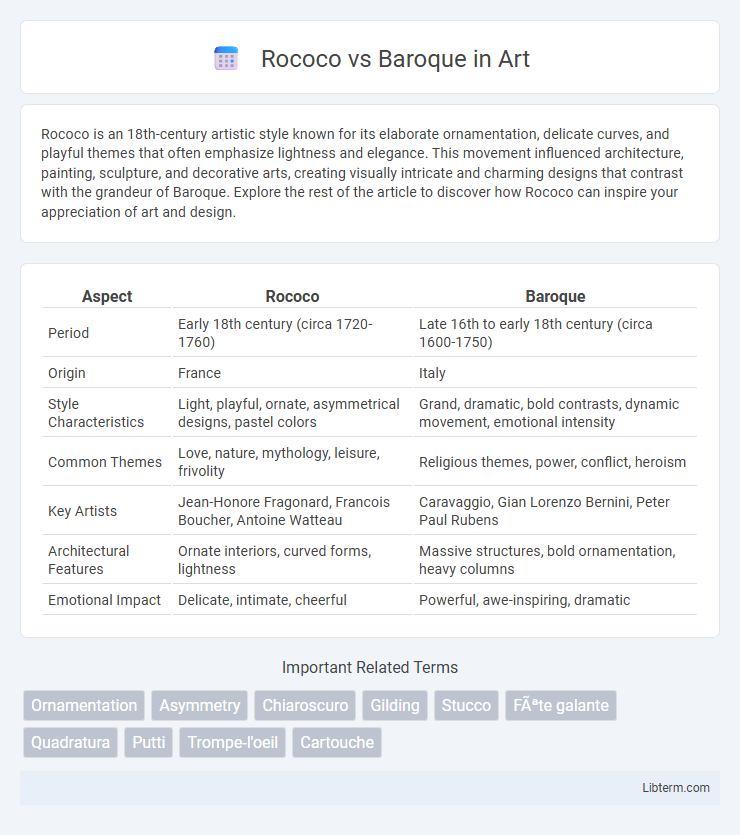Rococo is an 18th-century artistic style known for its elaborate ornamentation, delicate curves, and playful themes that often emphasize lightness and elegance. This movement influenced architecture, painting, sculpture, and decorative arts, creating visually intricate and charming designs that contrast with the grandeur of Baroque. Explore the rest of the article to discover how Rococo can inspire your appreciation of art and design.
Table of Comparison
| Aspect | Rococo | Baroque |
|---|---|---|
| Period | Early 18th century (circa 1720-1760) | Late 16th to early 18th century (circa 1600-1750) |
| Origin | France | Italy |
| Style Characteristics | Light, playful, ornate, asymmetrical designs, pastel colors | Grand, dramatic, bold contrasts, dynamic movement, emotional intensity |
| Common Themes | Love, nature, mythology, leisure, frivolity | Religious themes, power, conflict, heroism |
| Key Artists | Jean-Honore Fragonard, Francois Boucher, Antoine Watteau | Caravaggio, Gian Lorenzo Bernini, Peter Paul Rubens |
| Architectural Features | Ornate interiors, curved forms, lightness | Massive structures, bold ornamentation, heavy columns |
| Emotional Impact | Delicate, intimate, cheerful | Powerful, awe-inspiring, dramatic |
Introduction to Rococo and Baroque Styles
Baroque and Rococo styles emerged as influential art movements in Europe during the 17th and 18th centuries, characterized by distinct aesthetic principles. Baroque art features dramatic expressions, grandeur, and rich detail emphasizing movement and contrast, while Rococo style is lighter, more ornamental, and playful, with pastel colors and intricate decorative elements. Both styles significantly impacted architecture, painting, and sculpture, reflecting the cultural and social dynamics of their respective periods.
Historical Origins and Development
Baroque art emerged in early 17th-century Europe, characterized by dramatic intensity, grandeur, and movement, originating in Italy and spreading across Catholic countries to reinforce religious themes during the Counter-Reformation. Rococo developed in early 18th-century France as a reaction to Baroque's formality, emphasizing lightness, elegance, and ornamental detail with a playful and pastoral aesthetic favored by the aristocracy. The transition from Baroque to Rococo reflected shifting cultural and political dynamics, with Rococo embodying the values of the Enlightenment and a retreat from the previous era's dramatic intensity.
Key Artistic Characteristics
Rococo art is characterized by lightness, elegance, and an abundance of curving natural forms, emphasizing pastel colors, asymmetry, and playful themes. Baroque art features dramatic intensity, bold contrasts of light and shadow, dynamic movement, and grandeur, often focused on religious and emotional subjects. Rococo's intricate decorative details contrast with Baroque's monumental scale and emotional depth, marking distinct artistic approaches within 17th and 18th-century European art.
Distinctive Architectural Features
Rococo architecture is characterized by intricate ornamentation, asymmetrical curves, pastel color palettes, and light, playful themes, often emphasizing interior spaces with elaborate stucco work and frescoes. In contrast, Baroque architecture features grandiose scale, dramatic use of light and shadow, bold forms, and heavy ornamentation, with a focus on monumental facades, large-scale columns, and dynamic movement in structural elements. The Rococo style prioritizes delicate, airy decorations and intimacy, whereas Baroque architecture aims for awe-inspiring grandeur and theatrical impact.
Notable Artists and Architects
Baroque art and architecture, characterized by grandeur and emotional intensity, prominently featured artists like Caravaggio, Bernini, and Rubens, known for dramatic use of light and intricate details. Rococo, emerging in the early 18th century, showcased the elegance and playfulness of artists such as Francois Boucher, Jean-Honore Fragonard, and architect Francois de Cuvillies, emphasizing ornate decoration and pastel colors. Architects like Gian Lorenzo Bernini shaped Baroque spaces with dynamic forms and grandiose designs, whereas Rococo architecture, seen in the works of Balthasar Neumann and Germain Boffrand, favored lighter, asymmetrical elements and intimate interior aesthetics.
Decorative Elements and Motifs
Rococo decorative elements emphasize lightness, asymmetry, and playful motifs such as shells, flowers, and scrolls, creating an ornate yet delicate aesthetic. Baroque design features bold, symmetrical patterns with dramatic contrasts, incorporating heavy gilding, cherubs, and acanthus leaves that emphasize grandeur and theatricality. Both styles use intricate detailing but Rococo favors elegance and whimsy, while Baroque presents a more opulent and dynamic visual impact.
Color Palettes and Themes
Baroque art features dramatic color palettes dominated by deep reds, golds, and dark shadows that evoke intensity and grandeur, while Rococo embraces light, pastel hues such as soft pinks, blues, and creams, creating a delicate and playful atmosphere. The Baroque style emphasizes themes of power, religious fervor, and emotional depth, often portraying dramatic scenes with strong contrasts between light and dark. In contrast, Rococo centers on themes of love, nature, and leisure, highlighting ornamental details and whimsical, romantic subjects.
Influence on Furniture and Interior Design
Rococo furniture and interior design are characterized by intricate asymmetrical ornamentation, pastel colors, and light, elegant forms that emphasize playful and whimsical themes. Baroque design features grand, bold, and symmetrical elements with dramatic contrasts, heavy ornamentation, and rich materials such as gilded wood and marble, reflecting power and opulence. The transition from Baroque to Rococo marked a shift from grandeur and formality toward more intimate and decorative spaces focused on comfort and artistic expression.
Impact on Modern Art and Culture
Baroque art's emphasis on dramatic intensity, grandeur, and emotional depth has influenced modern artistic movements such as Expressionism and Romanticism, shaping contemporary visual storytelling and theatrical design. Rococo's lightness, ornamental elegance, and playful themes have impacted modern decorative arts, fashion, and interior design, promoting a sense of sophistication and whimsy in cultural aesthetics. Both styles contribute uniquely to modern art and culture by blending emotional engagement with stylistic refinement and intricate detail.
Conclusion: Comparing Rococo and Baroque
Rococo and Baroque styles exhibit distinct characteristics, with Baroque emphasizing grandeur, dramatic contrasts, and intense emotional expression, while Rococo favors lightness, elegance, and playful ornamentation. Baroque architecture and art often showcase bold symmetry and monumental scale, whereas Rococo incorporates asymmetrical designs and delicate pastel colors. Understanding these differences highlights the evolution of European art from the 17th to the 18th century, reflecting shifts in cultural values and aesthetic preferences.
Rococo Infographic

 libterm.com
libterm.com